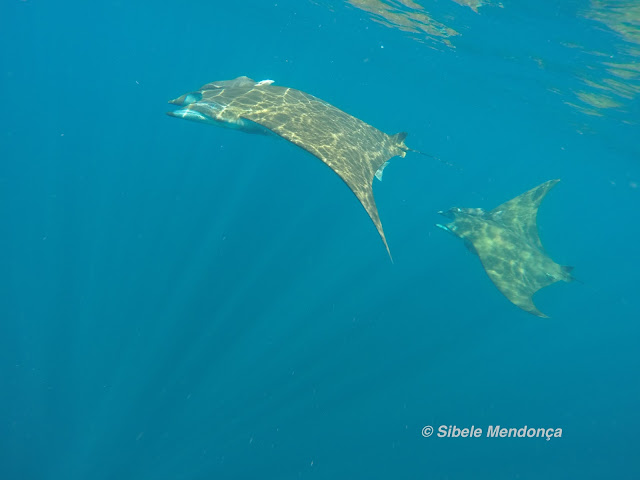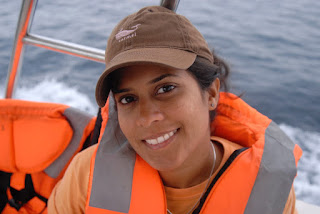In the blog and video below, MCAF grantee, Ramón Bonfil, PhD, founder and director of Océanos Vivientes, A.C. (Living Oceans) describes his recent expedition to tag devil rays in the Archipelago of St. Peter and St. Paul, 600 miles off the coast of Brazil.
by Ramón Bonfil
The 56-hour boat trip is grueling, with rough seas, a freezing cabin and an incredibly uncomfortable bed, but we finally get to the tiny rocks creeping out of the sea in the middle of the Atlantic Ocean, the Archipelago of St. Peter and St. Paul (ASPSP). Perhaps it’s surprising for a marine biologist, but I often get sea-sick and I just do not enjoy boats for more than a few hours, however the beauty of this little marine paradise is totally worth the hardship of the trip to get here! |
| The Archipelago of St. Peter and St. Paul (ASPSP) offers spartan quarters for researchers. |
Traders claim that the gill rakers of manta and devil rays have miraculous curative powers for all sorts of ailments and market them as traditional Chinese medicine. The reality is that there is absolutely no evidence of this being a traditional product in Chinese medicine, nor is there any scientific evidence that gill rakers cure any ailment.
The need to help turn the tide and protect devil and manta rays drives us to learn more about their life cycles, habitat needs and the threats they face. By inserting electronic tags that link to environmental satellites, we can follow the movements of the devil rays around the ocean and get detailed records of where they go, how deep — and how often — they dive, and what water temperatures they prefer and tolerate. We may find that they stick to small areas (such as the ASPSP), which can be more easily protected. Or they may migrate widely across the Atlantic Ocean, crossing into the waters of several countries and facing many threats, which would make them much more difficult to protect.
A Speck in the Ocean
I am here with Sibele Mendonça and Bruno Macena, graduate students and collaborators in the devil ray ecology project led by my friend and colleague Dr. Fabio Hazin, from the Department of Fisheries and Aquaculture of the Universidade Federal Rural de Pernambuco (UFRPE) in Recife, Brazil.During our stay, we will get to see the cute ‘atobás’ (brown booby birds, Sula leucogaster) with their romantic displays and fluffy nestlings, the beautiful ‘viuvinhas’ (brown and black noddies, Anous stolidus and A. minutus), dolphins and lots of silky, dusky Galapagos and hammerhead sharks (and if lucky a whale shark or two), in addition to the main attraction of our expedition…the Chilean devil ray (Mobula tarapacana) and its sibling, the bentfin devil ray (M. thurstoni).
 |
| A brown booby, Sula leucogaster, finds a perch at the research station. |
Into the Water
With our gear stowed and our tags calibrated, at last I set out on my first day on the water. This year, I’m hoping to improve on last year’s performance and place at least three tags with even more detailed data capabilities. I haven’t yet had time to prepare the tagging pole, so all I hope to accomplish on this first day is to find the devil rays, photograph/film them, and, most importantly, take tiny samples of muscle, so that we can do a genetic analyses of each individual. |
| An aerial drone helps the scientists locate groups of devil rays. |
Curiosity Tagged the Devil Ray
The next couple of days we do not get to see the devil rays. But eventually our luck comes back with a group of 4 devil rays next to the boat. When Sibele and I jump into the water, the devil rays circle back to check us out once they detect our presence.Chilean devil rays are very curious. More often than not, they come back to give us a look and see what we are up to, often gently ‘flying’ directly towards us, and — just when we think we will get to touch them — diving or turning to avoid us and keep their distance. Most times, they hang around us for three to five minutes, and sometimes come back for another couple of passes even after we tag them or pinch them for a little tissue sample. This is in stark contrast with the other devil ray inhabiting the ASPSP, the smoothtail devil ray M. thurstoni. Smoothtail devil rays are elusive and it is rare to see them while snorkeling.
 |
| Bonfil prepares to tag a devil ray. |
Our luck just gets better day after day, and in the next few days we obtain biopsy samples from more individuals and we manage to deploy two further miniPAT tags on the same day! One on a ca. 2.5 m male (Arturo) and the other on a ca. 2.3 m female (Genie, in honor of the late Genie Clark).
 |
| The team named this tagged devil ray “Arturo.” |
As we pack our gear to return to civilization, there is a bittersweet feeling of getting back to the comfort and ‘normality’ of life in a city, and the realization that we have to leave behind this fantastic place and the rewarding work we do here.
Following on a faculty fellowship visit to Dr. Fabio Hazin’s research group in Brazil, Bonfil and Hazin have formed a partnership to better understanding the biology and ecology of devil rays — as well as the threats they face — to design better conservation measures for them. The project is funded by MCAF and several other sources, including Save Our Seas Foundation, the Brazilian Research Council, the Interministerial Secretariat on Marine Resources, Universidade Federal Rural de Pernambuco and Oceános Vivientes A.C.
Additional information on manta ray conservation:
- MCAF In Action: Devils in Distress
- MCAF in Action: Building a Global Strategy for Mantas and Devil Rays
- Tagging Giants at the Revillagigedo Islands









































